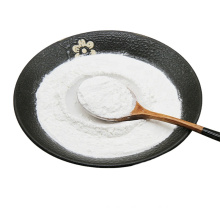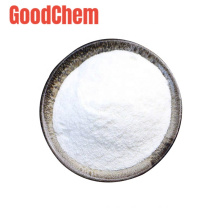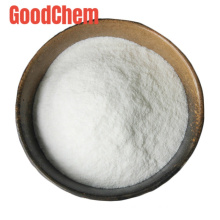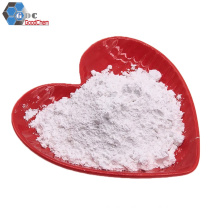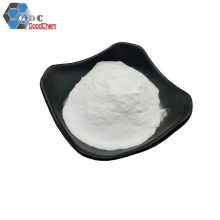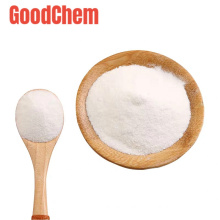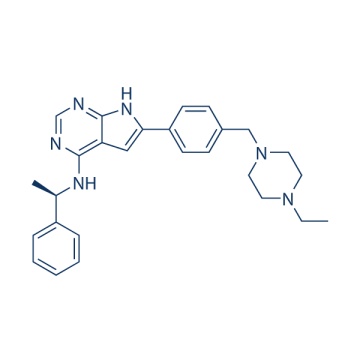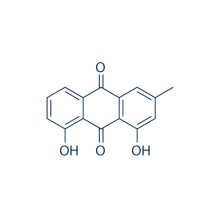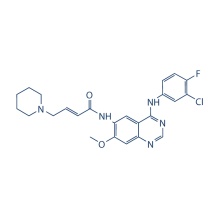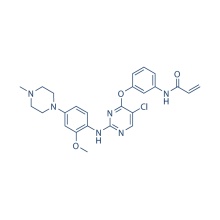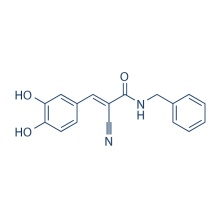.cp_wz table {border-top: 1px solid #ccc; border-left: 1px solid #ccc; } .cp_wz table td {border-right: 1px solid #ccc; borda inferior: 1px sólido #ccc; preenchimento: 5px 0px 0px 5px;} .cp_wz tabela th {border-right: 1px solid #ccc; border-bottom: 1px solid #ccc; preenchimento: 5px 0px 0px 5px;} \ n Peso molecular: \ n 440,58 AEE788 (NVP-AEE788) é um inibidor potente de EGFR e HER2 / ErbB2 com IC50 de 2 nM e 6 nM, menos potente para VEGFR2 / KDR, c- Abl, c-Src e Flt-1, não inibe Ins-R, IGF-1R, PKCα e CDK1. Fase 1/2. \ N A atividade biológica AEE788 também inibe KDR, c-abl, c-Src e Flt-1 com IC50 de 50-80 nM. AEE788 não é sensível a ErbB-4, PDGFR-β, Flt-3, Flt-4, RET e c-Kit e não tem inibição para Ins-R, IGF-1R, PKC-α e PKA. AEE788 inibe potentemente a fosforilação de EGFR em células A431 com IC50 de 11 nM. O AEE788 também inibe a fosforilação de KDR em células CHO e erbB2 em células BT-474, sem quaisquer efeitos na fosforilação induzida por PDGF em células A31. AEE788 inibe a proliferação de células NCI-H596, MK, BT-474 e SK-BR-3 com IC50 de 78, 56, 49 e 381 nM, respectivamente. Caso contrário, AEE788 tem a propriedade adicional de inibir a proliferação celular conduzida pelo mutante EGFR incluindo 32D / EGFR e 32D / EGFRvIII. O AEE788 também inibe a proliferação de HUVEC impulsionada por EGF e VEGF com IC50 de 43 e 155 nM, respectivamente. AEE788 inibe a fosforilação de EGFR, VEGFR2, Akt e MAPK em linhas de células SCC cutâneas humanas (células Colo16, HaCaT, SRB1 e SRB12), o que leva à inibição do crescimento e indução de apoptose. AEE788 inibe a fosforilação de EGFR e Akt em células HT29 em 0,2 a 1,0 μM. O AEE788 inibe a proliferação celular e evita a ativação de HER1, HER2 e HER3 induzida por EGF e neuregulina em linhas celulares de meduloblastoma. AEE788 mostra atividades supressoras de crescimento em células de meduloblastoma quimiossensíveis e quimiorresistentes. AEE788 produz uma inibição dependente da dose do crescimento do tumor em modelos de xenoenxerto NCI-H596 ou DU145, com apenas pequenas alterações de peso corporal. AEE788 induz a regressão do tumor em 57% a 50 mg / kg no modelo NeuT / erbB2 GeMag. O AEE788 inibe potentemente a fosforilação de EGFR induzida por EGF em tumores A431 e a fosforilação de erbB2 em tumores GeMag. O AEE788 inibe a angiogênese induzida por VEGF de maneira dependente da dose e não inibe a angiogênese induzida por bFGF. O AEE788 suprime o crescimento do volume do tumor em 54% em xenoenxertos Colo16 a 50 mg / kg, o que ocorre devido à inibição da fosforilação de EGFR, VEGFR, Akt e MAPK. AEE788 (50 mg / kg) também inibe o crescimento de tumores no ceco e peritônio (> 50%) e reduz a incidência de metástases em linfonodos para 70% em células HT29 implantadas no ceco de camundongos nus, sem perda de peso corporal e evidência bruta de neovascularização. AEE788 reduz significativamente os níveis de expressão de pEGFR e pVEGFR em tumores cecais HT29 e não altera aqueles de EGF, VEGF, EGFR ou VEGFR. Combinado com CPT-11, AEE788 tem tumores significativamente menores e inibição completa de metástases em linfonodos. AEE788 inibe o crescimento de xenoenxertos Daoy, DaoyPt e DaoyHER2 em 51%, 45% e 72%, respectivamente. O AEE788 pode promover a geração mediada por LBH589 de espécies reativas de oxigênio em células tumorais K562, que por sua vez aumentam a apoptose. Ensaio de cinase de protocolo (apenas para referência): [1]
|
Protein Kinase Assays
|
The in vitro kinase assays are performed in 96-well plates (30 μL) at ambient temperature for 15–45 min using the recombinant glutathione S-transferase-fused kinase domains (4-100 ng, depending on specific activity). [γ33P]ATP is used as phosphate donor and polyGluTyr-(4:1) peptide as acceptor. With the exception of protein kinase C-α, cyclin-dependent kinase 1/cycB and protein kinase A are protamine sulfate (200 μg/mL), histone H1 (100 μg/mL), and the heptapeptide Leu-Arg-Arg-Ala-Ser-Leu-Gly (known as Kemptide Bachem) respectively and are used as peptide substrates. Assays are optimized for each kinase using the following ATP concentrations: 1.0 μM (c-Kit, c-Met, c-Fms, c-Raf-1, and RET), 2.0 μM (EGFR, erbB2, ErbB3, and ErbB4), 5.0 μM (c-abl), 8.0 μM (Flt-1, Flt-3, Flt-4, Flk, KDR, FGFR-1, and Tek), 10.0 μM (PDGFR-β, protein kinase C-α, and cyclin-dependent kinase 1), and 20.0 μM (c-Src and protein kinase A). The reaction is terminated by the addition of 20 μL 125 mM EDTA. Thirty μL (c-abl, c-Src, insulin-like growth factor-1R, RET-Men2A, and RET-Men2B) or 40 μL (all other kinases) of the reaction mixture is transferred onto Immobilon-polyvinylidene difluoride membrane, presoaked with 0.5% H3PO4 and mounted on a vacuum manifold. Vacuum is then applied and each well rinsed with 200 μL 0.5% H3PO4. Membranes are removed and washed four times with 1.0% H3PO4 and once with ethanol. Dried membranes are counted after mounting in a Packard TopCount 96-well frame and with the addition of 10 μL/well of Microscint. IC50 values (±SE) are calculated by linear regression analysis of the percentage inhibition and are averages of at least three determinations.
|
Ensaio de células: [1]
|
Cell lines
|
T24, BT-474, SK-BR-3, and NCI-H596 cells
|
|
Concentrations
|
~10 μM
|
|
Incubation Time
|
4 or 6 days
|
|
Method
|
Methylene Blue Cell Proliferation Assay.Cells are seeded at 1.5 × 103 cells/well into 96-well microtiter plates and incubated overnight at 37 °C, 5% v/v CO2 and 80% relative humidity. AEE788 dilutions are added on day 1, with the highest concentration being 10 μM. After incubation of the cell plates for an additional 4 (T24) or 6 (BT-474, SK-BR-3, and NCI-H596) days, cells are fixed with 3.3% v/v glutaraldehyde, washed with water, and stained with 0.05% w/v methylene blue. After washing, the dye is eluted with 3% HCl and the absorbance measured at 665 nm with a SpectraMax 340 spectrophotometer. IC50 values are determined by mathematical curve-fitting and are defined as the drug concentration leading to 50% inhibition of net cell mass increase compared with untreated control cultures.
|
Estudo Animal: [1]
|
Animal Models
|
NCI-H596, DU145, A431, B16 and oncogenic NeuT-transfected HC11 cells in female BALB/c nu/nu (nude) mice
|
|
Formulation
|
N-methylpyrrolidone and PEG300 1:9 (v/v)
|
|
Dosages
|
50 mg/kg
|
|
Administration
|
Dosed orally
|
|
Solubility
|
30% PEG400/0.5% Tween80/5% propylene glycol,
30 mg/mL
|
|
* Please note that Selleck tests the solubility of all compounds in-house, and the actual solubility may differ slightly from published values. This is normal and is due to slight batch-to-batch variations.
|
Conversão de diferentes modelos de animais com base em BSA (valor com base em dados das diretrizes preliminares da FDA)
|
Species
|
Baboon
|
Dog
|
Monkey
|
Rabbit
|
Guinea pig
|
Rat
|
Hamster
|
Mouse
|
|
Weight (kg)
|
12
|
10
|
3
|
1.8
|
0.4
|
0.15
|
0.08
|
0.02
|
|
Body Surface Area (m2)
|
0.6
|
0.5
|
0.24
|
0.15
|
0.05
|
0.025
|
0.02
|
0.007
|
|
Km factor
|
20
|
20
|
12
|
12
|
8
|
6
|
5
|
3
|
|
Animal A (mg/kg) = Animal B (mg/kg) multiplied by
|
Animal B Km
|
|
Animal A Km
|
Por exemplo, para modificar a dose de resveratrol usada para um camundongo (22,4 mg / kg) para uma dose baseada na BSA para um rato, multiplique 22,4 mg / kg pelo fator Km para um camundongo e, em seguida, divida pelo fator Km para um rato. Este cálculo resulta em uma dose equivalente de rato para o resveratrol de 11,2 mg / kg.
|
Rat dose (mg/kg) = mouse dose (22.4 mg/kg) ×
|
mouse Km(3)
|
= 11.2 mg/kg
|
|
rat Km(6)
|
Informação Química
|
Molecular Weight (MW)
|
440.58
|
|
Formula
|
C27H32N6
|
|
CAS No.
|
497839-62-0
|
|
Storage
|
3 years -20℃Powder
|
|
6 months-80℃in solvent (DMSO, water, etc.)
|
|
Synonyms
|
|
|
Solubility (25°C) *
|
In vitro
|
DMSO
|
88 mg/mL
(199.73 mM)
|
|
Water
|
<1 mg/mL
(
|
|
Ethanol
|
<1 mg/mL
(
|
|
In vivo
|
30% PEG400/0.5% Tween80/5% propylene glycol
|
30 mg/mL
|
* <1 mg/ml means slightly soluble or insoluble.
* Please note that Selleck tests the solubility of all compounds in-house, and the actual solubility may differ slightly from published values. This is normal and is due to slight batch-to-batch variations.
|
|
Chemical Name
|
(R)-6-(4-((4-ethylpiperazin-1-yl)methyl)phenyl)-N-(1-phenylethyl)-7H-pyrrolo[2,3-d]pyrimidin-4-amine
|
Calculadora de molaridade Calculadora de diluição Calculadora de peso molecular
Grupo de Produto : Proteína Tirosina Quinase > Inibidor EGFR
